|
 Xeromphalina podocarpi Xeromphalina podocarpi
BiostatusPresent in region - Indigenous. Endemic
Images (click to enlarge)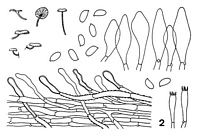
Caption: (type): carpophores, spores, basidia, cheilocystidia, cuticle | 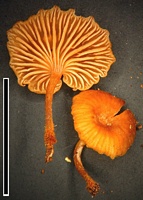
Caption: scale=1cm
Owner: J.A. Cooper | 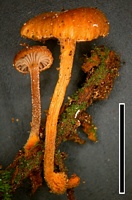
Caption: scale=5mm
Owner: J.A. Cooper | 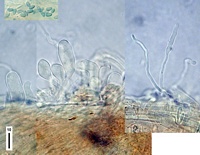
Caption: spores and caulocystidia
Owner: J.A. Cooper | 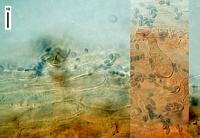
Caption: cap hyphae
Owner: J.A. Cooper | 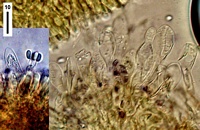
Caption: cheilocystidia
Owner: J.A. Cooper | 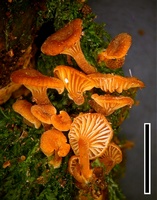
Caption: scale=5mm. Bsal yellow/brown tomentum present but not visible here.
Owner: J.A. Cooper | 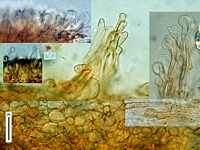
Caption: tope left: cheilocystidia. Middle left: pleurocystidia & spores. Middle, mid right and bottom: section through cap showing pilocystidia. Mid right: zebra encrusted cap hyphae.
Owner: J.A. Cooper | |
Article: Horak, E. (1980) [1979]. Xeromphalina and Heimiomyces in Indomalaya and Autralasia. Sydowia 32: 131-153.
Description: Pileus-8 mm, hemispheric or convex becoming expanded, always with defined eccentric umbilicus; ochraceous to yellow-brown, paler towards striate margin; smooth, dry, membranaceous. Lamellae (L 8 -10,-3) moderately crowded, decurrent; ochraceous-yellow, edge concolorous, even. Stipe-12 x-1 mm, eccentric or sublateral, cylindric, sometimes tapering towards base; ochraceous to orange, brown, base reddish brown; pruinose at apex, rhizomorphs absent, dry, tough, single or gregarious in dense groups. Odour none, taste bitterish. Context tough, pale yellow. Chemical reactions on pileus: KOH-brown. Spore print white.
Spores 3-4 x 1.5-2 µm, elliptic, hyaline, smooth, amyloid. Basidia 15-18 x 3-5 µm, 4-spored. Cheilocystidia 20-35 x 6 -10 µm, fusoid or lageniform, membranes hyaline, smooth, thin-walled. Pleurocystidia none. Caulocystidia like cheilocystidia. Cuticle a cutis or trichoderm of repent cylindric hyphae (4-8 µm diam.), membranes not gelatinised, terminal cells subclavate with thickened, brown (membranous and encrusting pigment) membranes. Clamp connections numerous.
Habitat: On rotten conifer wood (Podocarpus dacrydioides).- New Zealand.
Notes: Due to the yellow-brown colour of the carpophores X. podocarpi can be mistaken for X. leonina (MASSEE) which also occurs in New Zealand. The former species, however, is well characterised by its eccentric stipe, smaller spores and its habitat on conifers.
|